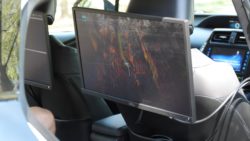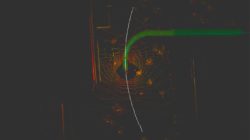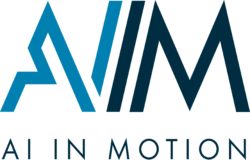We interviewed Gijs Dubbelman CTO of AIIM (AI in Motion) based in Eindhoven in the Netherlands about their experience of working with Velodyne LiDAR sensors with their projects

Gijs Dubbelman CTO of AIIM – AI in Motion
1. Tell me about what AI in Motion does?
At AIIM (Ai in Motion) we enable reliable mobile autonomous solutions in open, dynamic and unconditioned environments by utilising state of the art artificial intelligence and core vision technologies. Through our extensive research, our neural networks portfolio ranks among the best in the world, including best real-time performance. Our current developments include Hybrid 3D localisation solutions and deep learning 3D lidar based object detection and classification.
Our goal is to expand the level of automation in the selected sectors for the pioneering companies that embrace the use of AI technology. Our target markets are maritime, logistics, hospitality, agri-tech and new automotive. These sectors are searching for AI solutions which will prevent human faults and reduces costs as a result in the long term.
2. What is your role at AI in Motion?
As CTO of AIIM I am responsible for transforming abstract concepts and ideas into feasible products that can be applied in the markets we are focusing on.
3. How did the company start?
We were founded in February 2019 out of a discussion between Navinfo Europe and me. Both of us realized that a revolution is happening within localization and mapping technology by mixing this with the latest research on machine learning. As such we’ve concluded that the best way forward was to combine both channels of advanced research into products which add value to automated guided vehicles and robots in motion. Resulting in the birth of our start-up AIIM. We see a lot of opportunities to improve the quality of service and reducing costs within the development of such self-driving machines. And in markets such as maritime which so far have a more conservative approach when it comes to automation, we are happy to bring in our know-how and experience from our comfort zone, which is the automotive market.
4. What is your background?
I obtained my BSc. degree in Information and Communication Technology and MSc. Degree cum laude in Artificial intelligence form the University of Amsterdam. In 2011 I obtained my PhD. from the University of Amsterdam.
Beside CTO of AIIM I am also an assistant professor with the Eindhoven University of Technology, and I am heading the Mobile Perception Systems lab. The Mobile Perception Systems Lab researches methods in Artificial Intelligence that allow mobile autonomous systems to perceive their environment.
5. Tell us about the projects you are currently working on.
One of our current projects consists of a solution that can be used to localise itself purely by using LiDAR. This solution consists of a computation box, together with either a single or multiple LiDAR sensors, depending on the use case. It can be applied in any location that we can map with our mapping vehicle. Our system will then allow the customer vehicle to localize itself with millimetre accuracy all over this map. This gives it an advantage over regular positioning techniques such as transponders and GNSS. It costs a lot less to cover a large area compared to transponders. It also suffers less than GNSS from tree cover, large surrounding buildings, or going indoors. This makes it a good all-round localisation product that is flexible to its application.
6. How are you using LiDAR in those projects?
Most of the projects we have used LiDAR as their main source of information. This results in a product that can be used in many different environments and either with sensors that are tuned for the project, or just plug-in to an already existing system.

Besides that, we are not only relying on LiDAR, but we are combining it with other sensors as well, resulting in hybrid systems. We believe that such hybrid systems are the best solution for providing a robust but still flexible system with maximum safety.
7. What are the benefits of using LiDAR?
One of the nice things of working with LiDAR sensors is that they output a point cloud. These point clouds we can then use to run our algorithms.

Besides that, it is easier to determine distances and positions using LiDAR than with cameras. There are many algorithms that can very accurately detect objects on an image frame, but if you cannot convert those detections to a real-world position they are of no use. But, if you can project this image onto a 3D point cloud, then you will be able to place this detected object in the real world and take actions accordingly.
8. How are you finding using Velodyne sensors?
The Velodyne sensors have been one of the first “Puck” style LiDAR’s and it shows in the way that they are always very reliable and easy to use. They are definitively a safe pick for any project that highly values reliability and ease of use.
9. Can you tell us about a customer success story?
Within AIIM, we have a modified Toyota Prius that we are using for research, development, and demonstrations of our products. This vehicle is equipped with a large sensor array, such as multiple LiDAR’s, radars, and multiple types of cameras. We have obtained four Velodyne Pucks (VLP-16’s) from Mapix technologies that we are now using for forming a safety bubble around the car. This has already been in use for a number of years and have always worked without any problems from the moment we installed them on the vehicle.
10. What are your plans for the future?
We would like to become the trusted advisor in AI solutions for our clients and guide them through the steps that they need to take in order to reach the ultimate goal of autonomous operations. Our team are now building the building blocks like mapping, localisation, object detection, collision avoidance that will be required to safely and sustainably progress the use of automation.
11. Tell us about your experience of working with Mapix technologies
Because of the nature of our products and our customers, we are always expanding the range of sensors we are familiar with and to build our knowledge which sensors fit best for which environment. Mapix technologies is always very open and happy to help us obtain more information about these sensors and to make a selection.
For more information about AIIM – AI in Motion click here
Further information about Gijs can be found at and https://www.linkedin.com/in/gijsdubbelman/
See more about the range of Velodyne LiDAR sensors see here

